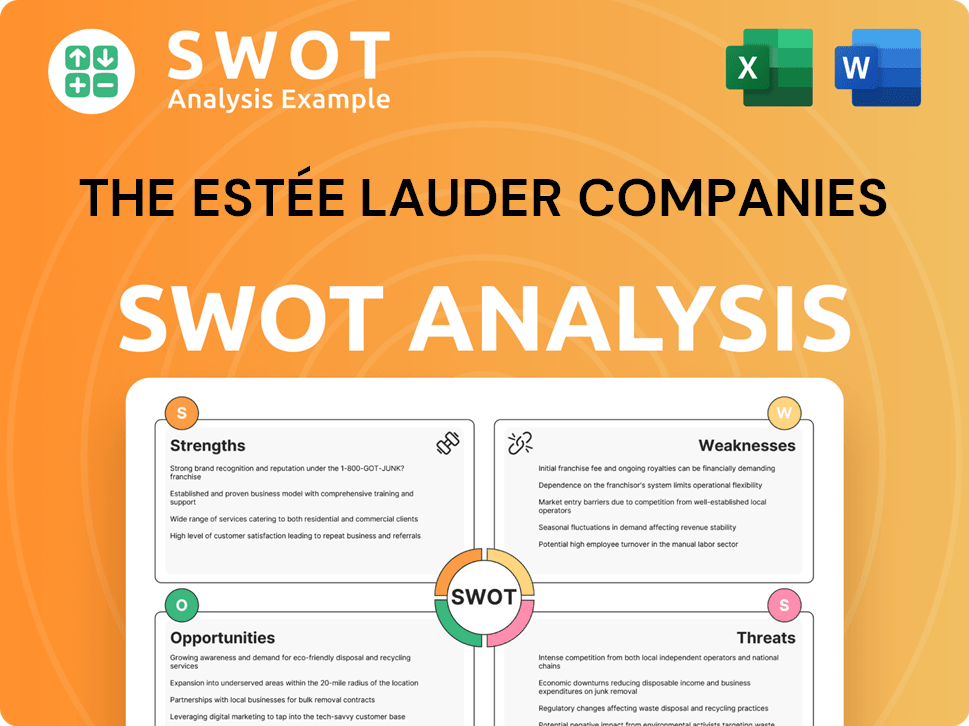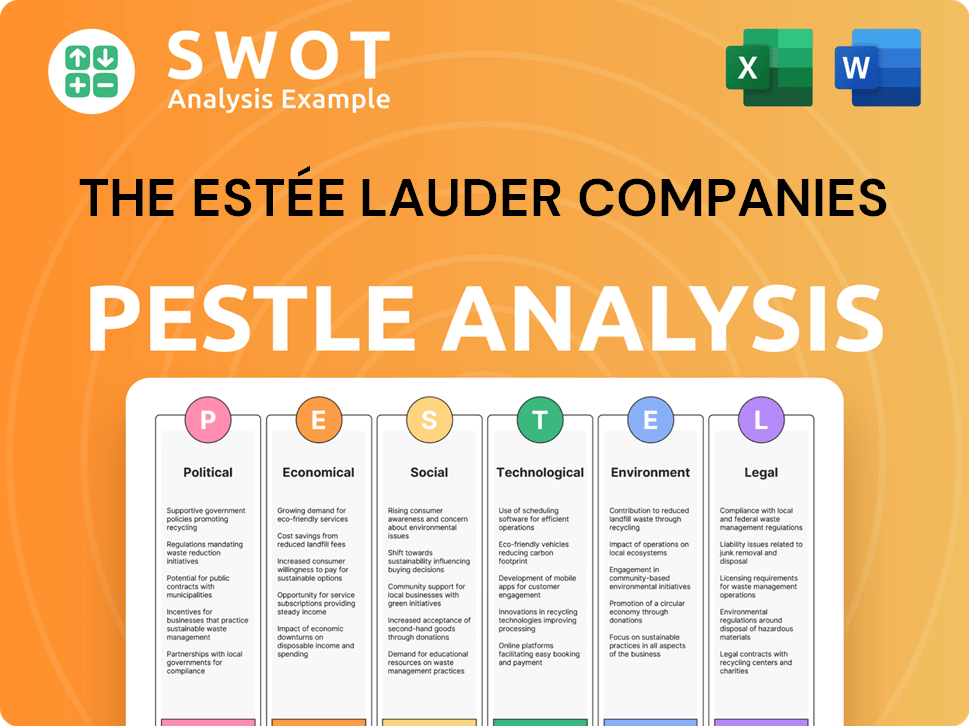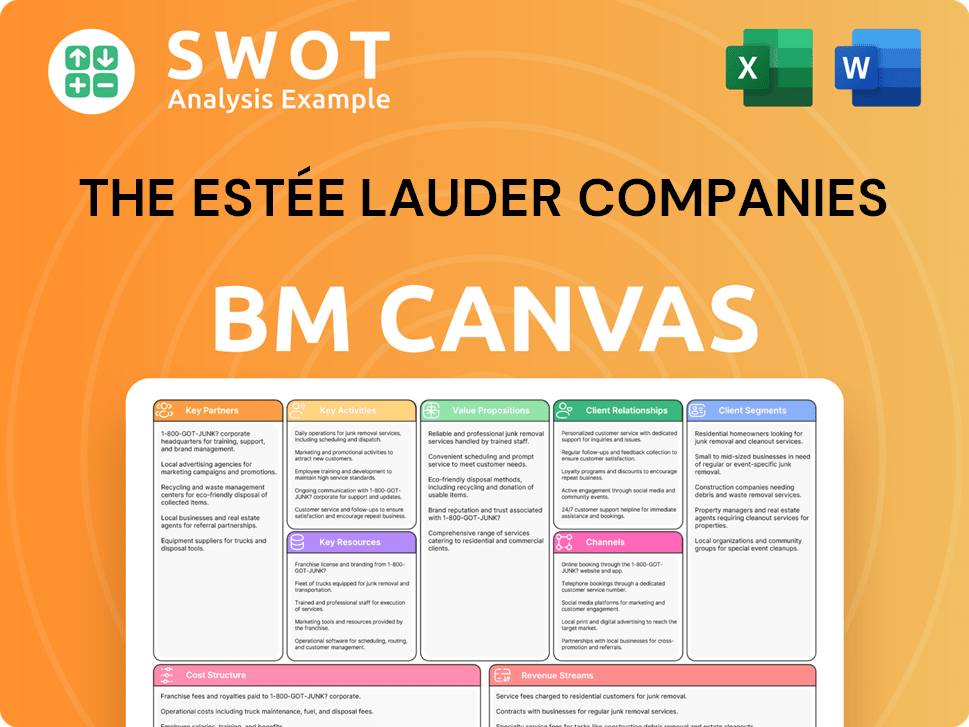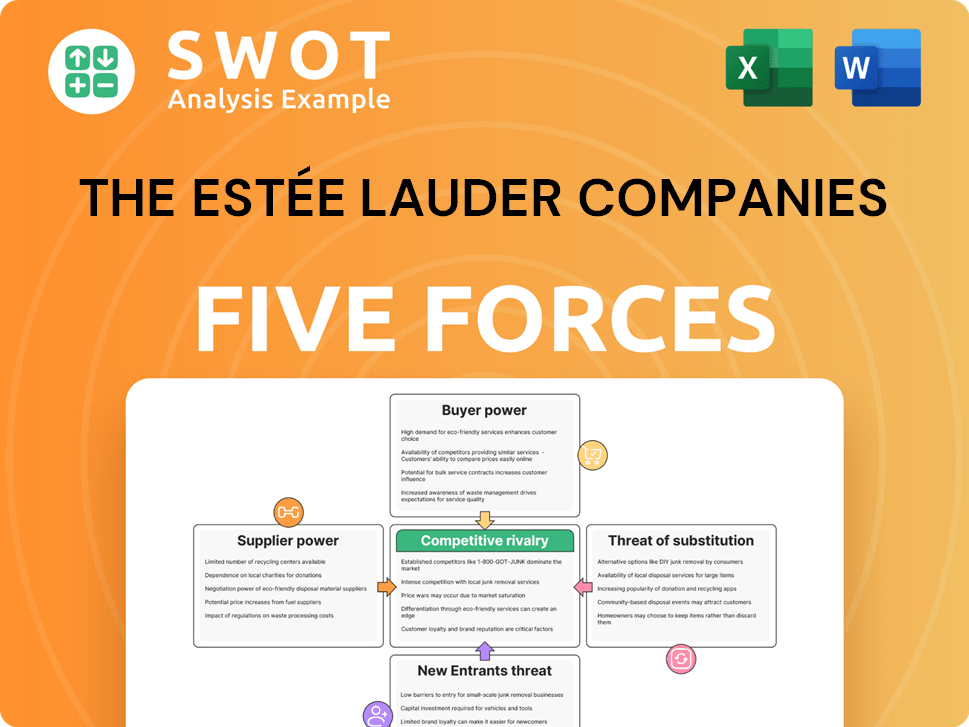The Estée Lauder Companies Bundle
How Does Estée Lauder Thrive in the Beauty Industry?
The Estée Lauder Companies (ELC) reigns supreme in the global prestige beauty industry, a realm defined by innovation and brand loyalty. With a powerhouse The Estée Lauder Companies SWOT Analysis reveals the secrets behind its success, offering a glimpse into its strategic prowess. Understanding how this cosmetics company operates is key to unlocking its enduring appeal.

From its impressive brand portfolio, including Estée Lauder and Clinique, to its global reach spanning over 150 countries, ELC's influence is undeniable. This exploration will dissect the company's business model, examining its marketing strategy, financial performance, and commitment to corporate social responsibility. Discover how Estée Lauder Companies navigates the ever-evolving beauty industry and continues to captivate consumers worldwide.
What Are the Key Operations Driving The Estée Lauder Companies’s Success?
The Estée Lauder Companies (ELC) creates and delivers value through its diverse portfolio of prestige beauty brands. This cosmetics company focuses on skincare, makeup, fragrance, and hair care, targeting various consumer segments. Their value proposition centers on product innovation, quality, brand equity, and a global presence, ensuring accessibility to its offerings.
ELC's operational processes are meticulously managed, covering research and development, manufacturing, and supply chain management. The company uses its own manufacturing facilities and third-party manufacturers to maintain quality and meet global demand. Distribution includes department stores, specialty retailers, and a growing direct-to-consumer channel.
Strategic partnerships further bolster market penetration. The company's core strengths include understanding consumer preferences, extensive R&D, and effective marketing strategies. These capabilities translate into superior product performance and strong brand connections, differentiating ELC from competitors. For more details on the company's ownership structure, check out Owners & Shareholders of The Estée Lauder Companies.
ELC's brand portfolio is a key aspect of its operations. The company owns a wide array of brands, each catering to different segments within the beauty industry. This diversified approach allows ELC to capture a broad consumer base and mitigate risks associated with individual brand performance.
ELC has a significant global presence, distributing its products worldwide. This international footprint is crucial for revenue generation and brand recognition. The company's ability to navigate diverse markets and adapt to local consumer preferences is a key driver of its success.
ELC's supply chain and manufacturing processes are critical for maintaining product quality and meeting demand. The company's operations include both in-house manufacturing and partnerships with third-party manufacturers. This allows ELC to ensure consistent quality and manage production costs effectively.
ELC has been expanding its direct-to-consumer (DTC) channels, including brand-dedicated stores and e-commerce platforms. This strategy allows the company to build stronger relationships with consumers and gather valuable data. The DTC approach also enhances brand visibility and provides a more personalized shopping experience.
ELC's core operations involve a combination of product innovation, brand building, and global distribution. The company's focus on research and development (R&D) is essential for creating new products and formulations. Marketing and advertising campaigns are crucial for building brand awareness and driving sales.
- R&D Investment: ELC invests significantly in R&D, with spending reaching approximately $400 million in fiscal year 2024.
- Marketing Spend: The company allocates a substantial portion of its revenue to marketing, with marketing expenses accounting for around 35% of net sales in fiscal year 2024.
- Global Sales: ELC generates a significant portion of its revenue from international markets, with approximately 70% of net sales coming from outside the Americas in fiscal year 2024.
- E-commerce Growth: E-commerce sales continue to grow, representing a significant and increasing percentage of total sales. In fiscal year 2024, e-commerce sales accounted for over 30% of the company's total sales.
The Estée Lauder Companies SWOT Analysis
- Complete SWOT Breakdown
- Fully Customizable
- Editable in Excel & Word
- Professional Formatting
- Investor-Ready Format

How Does The Estée Lauder Companies Make Money?
The Estée Lauder Companies (ELC) generates revenue primarily through the sale of prestige beauty products. Its diverse brand portfolio spans across skincare, makeup, fragrance, and hair care, catering to a global consumer base. Understanding its revenue streams and monetization strategies is key to grasping how the Estée Lauder Companies operates within the competitive beauty industry.
The Estée Lauder Companies employs a multifaceted approach to generate revenue, leveraging both traditional retail channels and innovative direct-to-consumer strategies. This approach allows the company to maintain a strong market presence and adapt to evolving consumer preferences. The company's success is underpinned by its ability to cultivate brand loyalty and expand its global footprint.
The company's revenue streams are primarily categorized into skincare, makeup, fragrance, and hair care. In the first quarter of fiscal year 2025, skincare accounted for approximately 56% of net sales, making it the largest contributor. Makeup followed, representing around 29% of net sales during the same period. Fragrance and hair care contribute the remaining significant portions of the revenue, showcasing a diversified product portfolio.
The Estée Lauder Companies utilizes several monetization strategies to maximize revenue and profitability. These strategies include direct-to-consumer sales, tiered pricing, and innovative marketing approaches.
- Direct-to-Consumer Channels: The company has invested significantly in its direct-to-consumer channels, including brand-owned e-commerce sites and freestanding stores. This strategy allows for higher profit margins and direct customer engagement.
- Tiered Pricing: The company employs tiered pricing strategies across its brand portfolio, catering to various luxury segments and price points.
- Innovative Marketing: The company uses limited-edition product releases, collaborations with influencers and designers, and loyalty programs to incentivize repeat purchases. The Marketing Strategy of The Estée Lauder Companies provides further insights into the company's promotional tactics.
- Geographic Variations: Revenue mix varies geographically, with Asia/Pacific often showing a higher contribution from skincare, while North America and Europe may see a more balanced mix across categories.
- Digital Acceleration and Data Analytics: The company focuses on digital acceleration and leverages data analytics to optimize product offerings and marketing campaigns.
The Estée Lauder Companies PESTLE Analysis
- Covers All 6 PESTLE Categories
- No Research Needed – Save Hours of Work
- Built by Experts, Trusted by Consultants
- Instant Download, Ready to Use
- 100% Editable, Fully Customizable

Which Strategic Decisions Have Shaped The Estée Lauder Companies’s Business Model?
The story of The Estée Lauder Companies (ELC) is one of strategic growth and adaptation, marked by key milestones that have solidified its position in the beauty industry. A notable recent move was the full acquisition of DECIEM, finalized in May 2024. This strategic investment significantly boosted ELC's presence in the rapidly expanding skincare market, catering to a younger, digitally-savvy consumer base.
Navigating challenges such as global supply chain disruptions and fluctuating consumer demand has been critical. The company responded by optimizing inventory management and accelerating its digital transformation initiatives. These efforts highlight ELC's commitment to maintaining its competitive edge in a dynamic market.
ELC's competitive advantages are multifaceted, stemming from its strong brand portfolio and global reach. Its ability to innovate and adapt to changing consumer preferences, including the growing demand for sustainable products, ensures its continued success. For a deeper dive into the company's strategic approach, consider reading about the Growth Strategy of The Estée Lauder Companies.
The full acquisition of DECIEM in May 2024 was a pivotal moment, expanding its skincare offerings. This strategic move built upon an initial investment in 2017. ELC's history is marked by consistent brand acquisitions and expansions.
ELC consistently invests in research and development to create innovative products. Digital transformation and enhanced supply chain management have been key strategies. The company focuses on adapting to evolving consumer preferences.
ELC's diverse brand portfolio and global recognition create strong consumer trust. Its robust R&D capabilities drive innovation. Economies of scale and a vast distribution network provide a significant advantage.
Global supply chain disruptions and changing consumer demand have presented challenges. ELC responded by optimizing inventory and accelerating digital initiatives. These efforts are crucial for maintaining market leadership.
ELC's competitive edge is built on several pillars, including a strong brand portfolio and global recognition. The company's investment in R&D ensures a steady stream of innovative products, catering to evolving consumer needs.
- Brand Strength: Strong consumer trust and loyalty across diverse brands.
- Innovation: Robust R&D leading to high-performance products.
- Global Reach: Extensive distribution network and widespread product availability.
- Adaptability: Commitment to sustainable practices and digital platforms.
The Estée Lauder Companies Business Model Canvas
- Complete 9-Block Business Model Canvas
- Effortlessly Communicate Your Business Strategy
- Investor-Ready BMC Format
- 100% Editable and Customizable
- Clear and Structured Layout

How Is The Estée Lauder Companies Positioning Itself for Continued Success?
The Estée Lauder Companies (ELC) holds a prominent position within the global prestige beauty market, competing with a select group of multinational corporations. ELC's diverse brand portfolio and global reach contribute to its strong market share across key categories like skincare, makeup, fragrance, and hair care. The company's presence in over 150 countries and territories further solidifies its industry standing, making it a significant player in the beauty industry.
However, ELC faces several challenges. These include regulatory changes, intense competition, technological disruptions, and shifting consumer preferences. Geopolitical instability and economic downturns can also influence consumer spending on luxury beauty products, posing additional risks to the company's performance. Understanding these factors is crucial for investors and stakeholders analyzing the company's long-term prospects.
ELC is a dominant force in the prestige beauty market. Its wide-ranging brand portfolio and global footprint give it significant market share. The company's strong brand recognition and consumer loyalty are key assets.
ELC faces risks from regulatory changes, competition, and technological disruption. Consumer preferences for sustainability and clean beauty also present challenges. Economic downturns and geopolitical instability can affect sales.
ELC is focused on digital transformation and expansion in emerging markets. The company is investing in 'clean beauty' and sustainable practices. Strategic brand management and product innovation are key to long-term growth.
ELC is accelerating its digital transformation and expanding in high-growth markets. Investments in 'clean beauty' and sustainable practices are also priorities. Leadership is committed to long-term growth through brand management and innovation.
To maintain its leadership, ELC is focused on several strategic initiatives. These initiatives aim to leverage its brand equity and global infrastructure to capitalize on new beauty trends and maintain its position in the dynamic prestige beauty landscape. The company's approach involves a blend of innovation, market expansion, and operational excellence.
- Digital Transformation: Enhancing its e-commerce capabilities and digital marketing strategies to reach consumers effectively.
- Emerging Markets: Expanding its presence in high-growth markets to tap into new consumer bases.
- Product Innovation: Continuing to innovate within its core categories to meet evolving consumer preferences.
- Sustainability: Investing in 'clean beauty' and sustainable practices to align with changing consumer values.
The Estée Lauder Companies Porter's Five Forces Analysis
- Covers All 5 Competitive Forces in Detail
- Structured for Consultants, Students, and Founders
- 100% Editable in Microsoft Word & Excel
- Instant Digital Download – Use Immediately
- Compatible with Mac & PC – Fully Unlocked

Related Blogs
- What are Mission Vision & Core Values of The Estée Lauder Companies Company?
- What is Competitive Landscape of The Estée Lauder Companies Company?
- What is Growth Strategy and Future Prospects of The Estée Lauder Companies Company?
- What is Sales and Marketing Strategy of The Estée Lauder Companies Company?
- What is Brief History of The Estée Lauder Companies Company?
- Who Owns The Estée Lauder Companies Company?
- What is Customer Demographics and Target Market of The Estée Lauder Companies Company?
Disclaimer
All information, articles, and product details provided on this website are for general informational and educational purposes only. We do not claim any ownership over, nor do we intend to infringe upon, any trademarks, copyrights, logos, brand names, or other intellectual property mentioned or depicted on this site. Such intellectual property remains the property of its respective owners, and any references here are made solely for identification or informational purposes, without implying any affiliation, endorsement, or partnership.
We make no representations or warranties, express or implied, regarding the accuracy, completeness, or suitability of any content or products presented. Nothing on this website should be construed as legal, tax, investment, financial, medical, or other professional advice. In addition, no part of this site—including articles or product references—constitutes a solicitation, recommendation, endorsement, advertisement, or offer to buy or sell any securities, franchises, or other financial instruments, particularly in jurisdictions where such activity would be unlawful.
All content is of a general nature and may not address the specific circumstances of any individual or entity. It is not a substitute for professional advice or services. Any actions you take based on the information provided here are strictly at your own risk. You accept full responsibility for any decisions or outcomes arising from your use of this website and agree to release us from any liability in connection with your use of, or reliance upon, the content or products found herein.